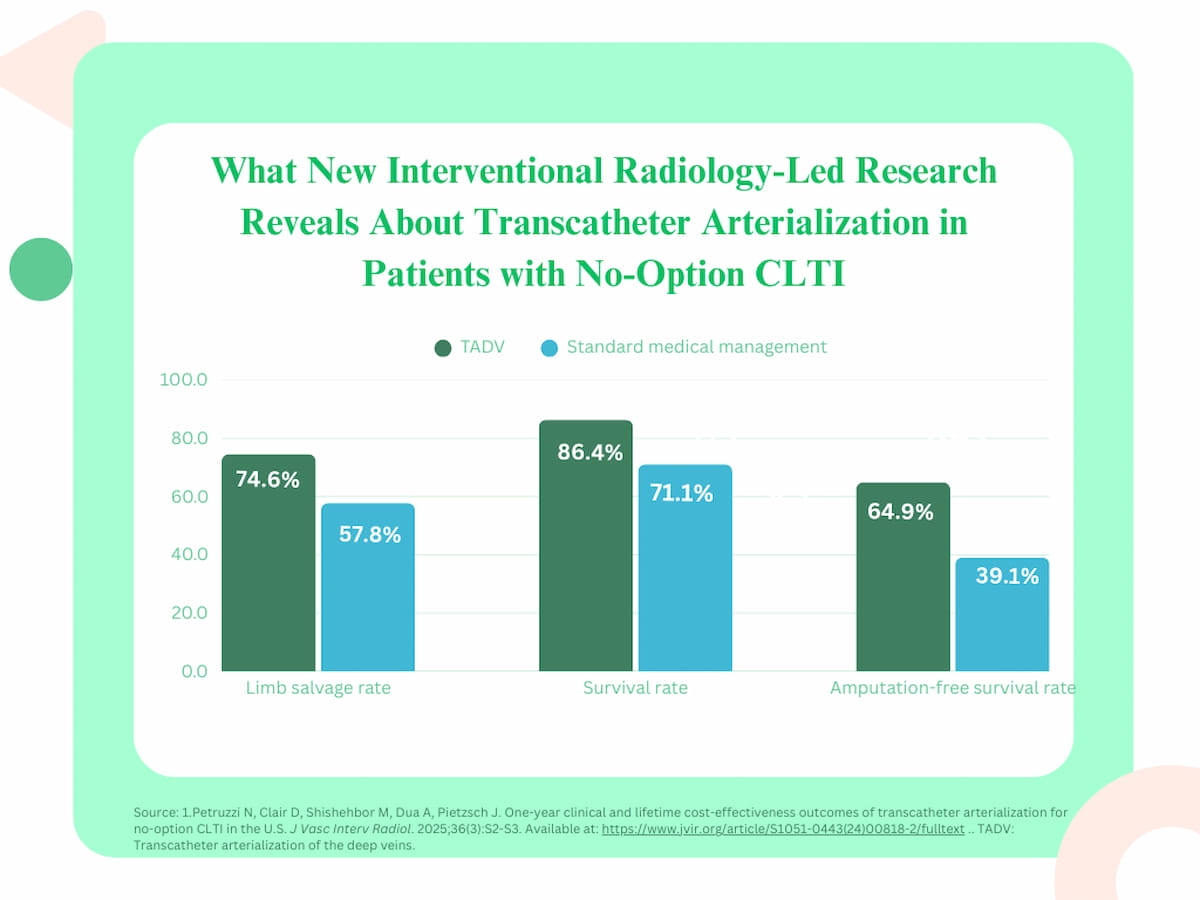Interventional Radiology-Led Study Shows Significant Limb Salvage Benefits with Transcatheter Arterialization
For patients with no-option chronic limb-threatening ischemia (CLTI), transcatheter arterialization provided over a 25 percent higher amputation-free survival rate over standard medical management at one year, according to research presented at the Society of Interventional Radiology (SIR) Annual Scientific Meeting.
Transcatheter arterialization of the deep veins (TADV) facilitates significantly improved outcomes in patients with chronic limb-threatening ischemia (CLTI) who are not eligible for open or endovascular treatment, according to new research presented at the Society of Interventional Radiology (SIR) Annual Scientific Meeting.
For the study, researchers employed propensity-score matching to compare TADV (LimFlow System, Inari Medical) versus standard medical management in 228 patients with CLTI who were not eligible for open or endovascular treatment (also referred to as patients with “no-option” CLTI).
In new research presented at the Society of Interventional Radiology (SIR) Annual Scientific Meeting, transcatheter arterialization of the deep veins (TADV) provided significantly improved limb salvage, survival and amputation-free survival rates in comparison to standard medical management in patients with no-option chronic limb-threatening ischemia (CLTI).

The study authors found that patients in the TADV cohort had a 16.8 percent higher limb salvage rate (74.6 percent vs. 57.8 percent), a 15.3 percent higher survival rate (86.4 percent vs. 71.1 percent) and a 25.8 percent higher amputation-free survival rate (64.9 percent vs. 39.1 percent).
“TADV was associated with significantly improved limb salvage, survival, and amputation-free survival at 1 year compared to contemporary benchmark for no-option CLTI patients,” wrote lead study author and interventional radiologist Nicholas Petruzzi, M.D., FSVM, DABR, who is affiliated with Atlantic Medical Imaging in New Jersey, and colleagues.
(Editor’s note: For related content, see “Diagnosing Cardiac Ischemia in Women: Key Imaging Considerations,” “What New Computed Tomography Research Reveals About Predicting Diabetes and Cardiometabolic Risks” and “Predicting Diabetes on CT Scans: What New Research Reveals with Pancreatic Imaging Biomarkers.”)
Findings from the research, which garnered “Abstract of the Year” honors with three other abstracts presented at the SIR conference, also revealed that TADV was a cost-effective option that may increase life expectancy in patients with no-option CLTI by more than two years in comparison to standard medical management.
“Over a patient’s lifetime, TADV added 1.09 (quality-adjusted life years) QALYs (2.25 vs 1.16) with a resulting ICER (incremental cost-effectiveness ratio) of $33,011 per QALY gained. The total projected survival gain with TADV was 2.18 life years,” pointed out Petruzzi and colleagues.
Reference
1. Petruzzi N, Clair D, Shishehbor M, Dua A, Pietzsch J. One-year clinical and lifetime cost-effectiveness outcomes of transcatheter arterialization for no-option CLTI in the U.S. J Vasc Interv Radiol. 2025;36(3):S2-S3. Available at: https://www.jvir.org/article/S1051-0443(24)00818-2/fulltext .
SNMMI: Botox May Facilitate Relief from Dry Mouth Side Effect of PSMA-Targeted Radiopharmaceuticals
June 25th 2025For patients being treated with radiopharmaceutical agents for metastatic prostate cancer, the combination of botulinum toxin and an anti-nausea patch led to a 30 percent reduction in PSMA uptake in the salivary glands, according to preliminary research findings presented at the SNMMI conference.
SNMMI: Can 18F-Fluciclovine PET/CT Bolster Detection of PCa Recurrence in the Prostate Bed?
June 24th 2025In an ongoing prospective study of patients with biochemical recurrence of PCa and an initial negative PSMA PET/CT, preliminary findings revealed positive 18F-fluciclovine PET/CT scans in over 54 percent of the cohort, according to a recent poster presentation at the SNMMI conference.
Could an Emerging PET Tracer be a Game Changer for Detecting Hepatocellular Carcinoma?
June 23rd 2025In addition to over 90 percent sensitivity in detecting hepatocellular carcinoma (HCC), the glypican-3 (GPC3) targeted PET tracer 68Ga-aGPC3-scFv appeared to be advantageous in identifying HCC tumors smaller than one centimeter, according to pilot study findings presented at the SNMMI conference.
SNMMI: What a New Meta-Analysis Reveals About Radiotracers for PET/CT Detection of PCa
June 22nd 2025While (68Ga)Ga-PSMA-11 offers a pooled sensitivity rate of 92 percent for prostate cancer, (18F)-based radiotracers may offer enhanced lesion detection as well as improved imaging flexibility, according to a meta-analysis presented at the Society for Nuclear Medicine and Molecular Imaging (SNMMI) conference.
SNMMI: Can Multimodal Monitoring Bolster Outcomes with Pluvicto in Treating mCRPC?
June 22nd 2025Multimodal treatment monitoring, including SPECT/CT exams 24 hours after treatment with Lu-177 PSMA-617, may have facilitated significantly shorter therapy durations and reduced side effects in patients with mCRPC, according to a two-year study presented at the Society for Nuclear Medicine and Molecular Imaging (SNMMI) conference.